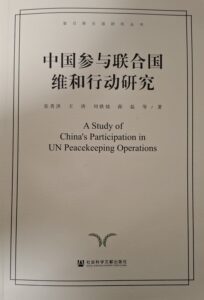
Zhang Guihong 张贵洪, Wang Tao 王涛, Liu Tiewa 刘铁娃, & Xue Lei薛磊
Social Science Academic Press, Beijing, 2024.
Reviewed by: Pawan Damodar Amin (PhD Candidate, Jawaharlal Nehru University, HYI Visiting Fellow)
Introduction
Unpacking Peacekeeping, and nations’ approach towards this subject is a complicated endeavor. Not only because of the shifting political goal post of what a successful peace-keeping operation looks like, but also because the flexibility inherent in the task in order to meet the needs of unique and evolving conflict situations globally. Give this, finding a one-size-fit-all solution is foolhardy, but trying to summarize and find a common threat in decades worth of a country’s approach in one book is, to put it mildly, a complicated endeavor. A challenge that could only be met by bringing together authors with diverse and rich experience in both academia and policy. This project benefits from such expertise.
Peacekeeping with Chinese Characteristics?
Initiating a peacekeeping operation requires the political intent of the international community and the willingness of the host nation. A successful execution of such an operation, however, requires the continuous cooperation of the host nation and the parties in conflict over an extended period of time. It is this emphasis on ensuring a host nation’s consent where, according to the authors, China’s approach to sanctioning peacekeeping operations differs from the other P5 member nations.
This book further highlights the difference between the “liberal-peace” approach of the West, which emphasizes political institution building, with the “developmental-peace” approach of China which focuses on ensuring economic and social stability. The book argues that the democratic institutions established in the former approach does not solve the root cause of the conflict, and eventually falls apart after the peace keeping forces withdraw. On the other hand, the “developmental-peace” approach works towards building stability from the ground up. This makes for a more lasting solution, since the host nation, governments and people become stakeholders, who benefit from the lasting peace.
Over the course of ten chapters, the book also covers different aspects of China’s participation in the peacekeeping operations. This includes, the organizational structure of peacekeeping-operations domestically. The book fleshes out the coordination mechanism between the Ministry of Foreign Affairs, the Ministry of Public Security and the Central Military Commission while explaining the division of responsibilities. It also goes into detail regarding the recruitment process for peacekeeping police and officers and the provincial level agencies responsible for specific peace-keeping operations.
In other sections, the book also highlights the tactical expertise gained by the Chinese peacekeeping officers through training and deploying with detachments of other nations. Of particular significance is the evolved understanding of operational philosophies and procedures of Western nations, especially NATO countries. At the same time, participation in UN Peacekeeping missions has also enabled China to deepen military to military connections with the developing countries who are the major troop contributors to peacekeeping operations. The book also teases out the financial commitments China has made to peacekeeping, both through the UN Peacekeeping operations and bilaterally through agreements signed with regional organizations like the African Union, and also supplemental financial assistance China provides through cooperation with other multilateral agencies like the South-South Triangular Cooperation with the International Fund for Agriculture and Development. It further provides rich details on the training provided by Chinese peacekeeping forces to the military, police and medical personnel of the host nations.
The book ends with an appreciation of the evolved security situation brought about through protracted intra-state conflict. It reflects on the new norms in the realm of peacekeeping operations in UN, like peace making and peace enforcement which demand a more active military role from the peacekeeping troops. This, the authors contend, makes it pertinent on China to contribute to norm and discourse creation which reflects and promotes China’s values and interests. However, they shy away from suggesting how China could go about shaping those norms and discourses.
Critical Assessment
The limitation of this projects is in its lack of reflection on operations that Chinese peacekeeping forces have been participating in for a considerable time, without a favorable solution in sight. For instance, the book highlights the successes of China’s peacekeeping officers and engineers who participated in the MONUSCO mission in Democratic Republic of Congo, but it does not reflect on the limitations of implementing a “developmental-peace” approach in areas of protracted intra-state conflict. In such situations, the book does not bring to fore any thoughts on the protection of civilians caught in protracted conflict where obtaining host-nation consent is politically complicated.
Why Read This Book? – Conclusion
This book provides a rich and detailed history of China’s participation and interactions with the global peace and security architecture. The authors deserve to be commended for going a step beyond the UN peacekeeping operations – which the title of the project holds them to – and exploring China’s participation in mediation and peacekeeping through bilateral and regional forums that supplement China’s efforts through the UN peacekeeping operations. The book provides an up to date assessment of China’s peacekeeping operations and explores both the domestic impetus and the foreign policy goals served by China’s approach. It also mentions in detail how the peacekeeping forces are organized structurally within China’s security and foreign policy apparatus.
While the book provides a Chinese perspective on peacekeeping, it does not provide any evidence to demonstrate the success of China’s approach, where the alternative was failing. At the same time, the book is also candid in its admission of how China uses sanctioning of peacekeeping operations to further its political goals in countries which continue to diplomatically recognize Taiwan. Given its rich source of primary data which is layered with an explanation of Chinese approach and perspectives, this book will be a useful tool to any researcher wishing to understand the contours of China’s approach to conflict resolution.
